Amsted Industries Bundle
How Well Do You Know Amsted Industries?
Ever wondered how a company born from the railroad industry became a global manufacturing giant? Amsted Industries, a name synonymous with industrial innovation, boasts a fascinating history of strategic adaptation and growth. From its humble beginnings in the early 20th century to its current status as a diversified powerhouse, Amsted's journey is a testament to resilience and foresight.
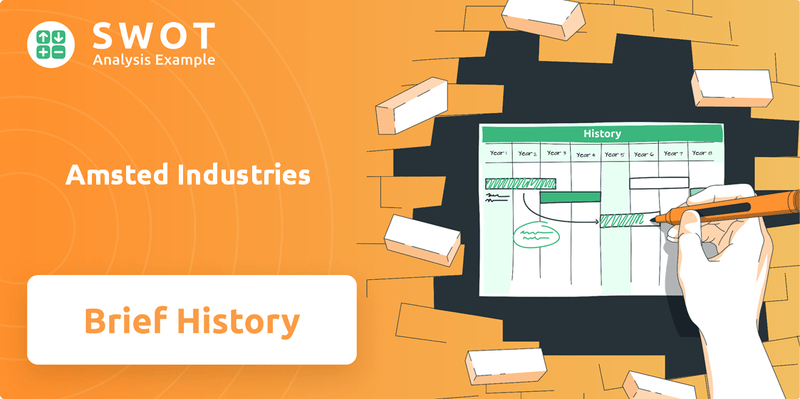
This Amsted Industries SWOT Analysis offers a glimpse into the company’s evolution, revealing its pivotal moments and strategic shifts. Delving into the brief history of Amsted Industries, we'll uncover its founding, early expansion, and the significant milestones that shaped its trajectory. Understanding the Amsted company profile provides valuable insights into its enduring impact on the manufacturing landscape and its continued relevance in today's market, especially within the railroad industry.
What is the Amsted Industries Founding Story?
The story of Amsted Industries, a prominent player in the manufacturing sector, begins with its establishment on June 26, 1902. Initially known as American Steel Foundries (ASF), the company's formation was a strategic merger rather than the brainchild of a single founder. This consolidation brought together eight plants across New Jersey and Illinois, marking the inception of what would become a significant industrial entity.
This strategic move was inspired by the success of large-scale industrial consolidations, such as United States Steel. Key figures involved in the creation of U.S. Steel, including Judge Elbert H. Gary and Charles M. Schwab, played pivotal roles in the formation of ASF. The primary goal was to enhance efficiency and market presence within the rapidly evolving American economy.
The initial challenge addressed by these industrial leaders was the competitive disadvantage faced by independent steel companies during the rapid industrialization of the early 20th century. The merger aimed to achieve economies of scale and strengthen market positioning. ASF's original business model focused on manufacturing cast steel freight components, primarily for the expanding railroad industry. In 1910, the company established a product engineering facility in Granite City, Illinois, expanding testing to include components like springs, demonstrating an early commitment to product development. The company's initial funding came from the combined assets of the merging entities.
Amsted Industries, originally American Steel Foundries (ASF), was formed on June 26, 1902, through a merger of several steel companies. This strategic move was influenced by the success of earlier industrial consolidations. The primary focus was on manufacturing cast steel freight components for the railroad industry.
- The merger involved eight plants across New Jersey and Illinois.
- Key figures from U.S. Steel were instrumental in ASF's formation.
- The initial business model centered on serving the railroad industry.
- A product engineering facility was established in 1910.
Amsted Industries SWOT Analysis
- Complete SWOT Breakdown
- Fully Customizable
- Editable in Excel & Word
- Professional Formatting
- Investor-Ready Format
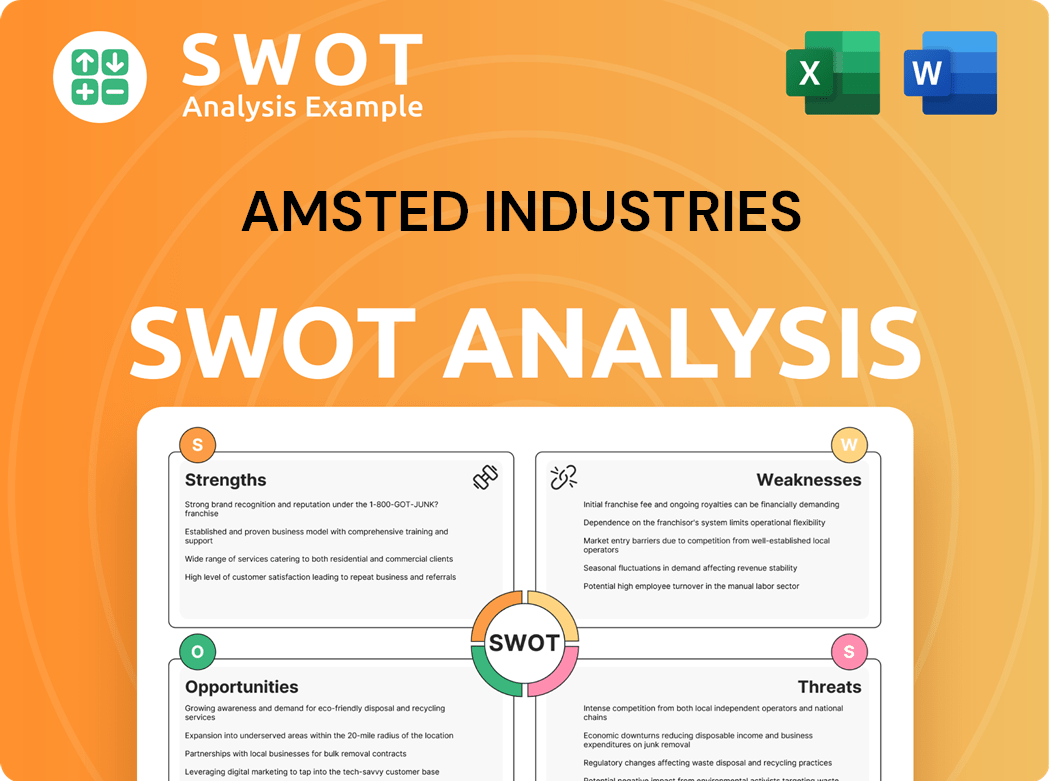
What Drove the Early Growth of Amsted Industries?
The early years of Amsted Industries, then known as American Steel Foundries (ASF), were marked by significant growth and adaptation. Initially focused on the railroad industry, the company quickly diversified its product offerings and expanded its manufacturing capabilities. This period saw strategic acquisitions and a shift in focus, laying the groundwork for the multi-industry presence that defines the company today.
During World War I, ASF played a critical role in manufacturing shell casings, producing over a million units by the war's end. After the war, ASF ventured into the automotive industry, manufacturing smaller springs for automobiles, though this was short-lived. A pivotal strategic shift occurred when ASF converted an idle factory in Council Bluffs, Iowa, into a water pipe manufacturing plant.
Key acquisitions marked this period of growth, including the King Machine Tool Company in 1948 and Diamond Chain Company in December 1950. In 1962, recognizing its expanded scope beyond steel foundries, the company officially changed its name to Amsted Industries. This name change reflected the company's broader diversification beyond its initial focus on the railroad industry.
Further expansion through acquisitions continued, including Macwhyte, a wire rope manufacturer, and Burgess-Norton, which produced piston pins and powdered metal parts. Amsted acquired Standard Automotive Parts in 1969, merging it with Burgess-Norton, and in 1970, purchased Extron Corporation, a plastic pipe and fittings manufacturer. The company also acquired Glamorgan Pipe & Foundry Company in 1971 and J&B Plastics in 1973.
In 1975, Amsted entered the filtration business by acquiring Hydromation Company. These strategic acquisitions and product diversifications were crucial in shaping Amsted Industries into the multi-faceted manufacturer it is today. This allowed the company to navigate competitive landscapes and respond to evolving industrial needs. The company's ability to adapt and diversify has been a key factor in its long-term success within the manufacturing sector.
Amsted Industries PESTLE Analysis
- Covers All 6 PESTLE Categories
- No Research Needed – Save Hours of Work
- Built by Experts, Trusted by Consultants
- Instant Download, Ready to Use
- 100% Editable, Fully Customizable
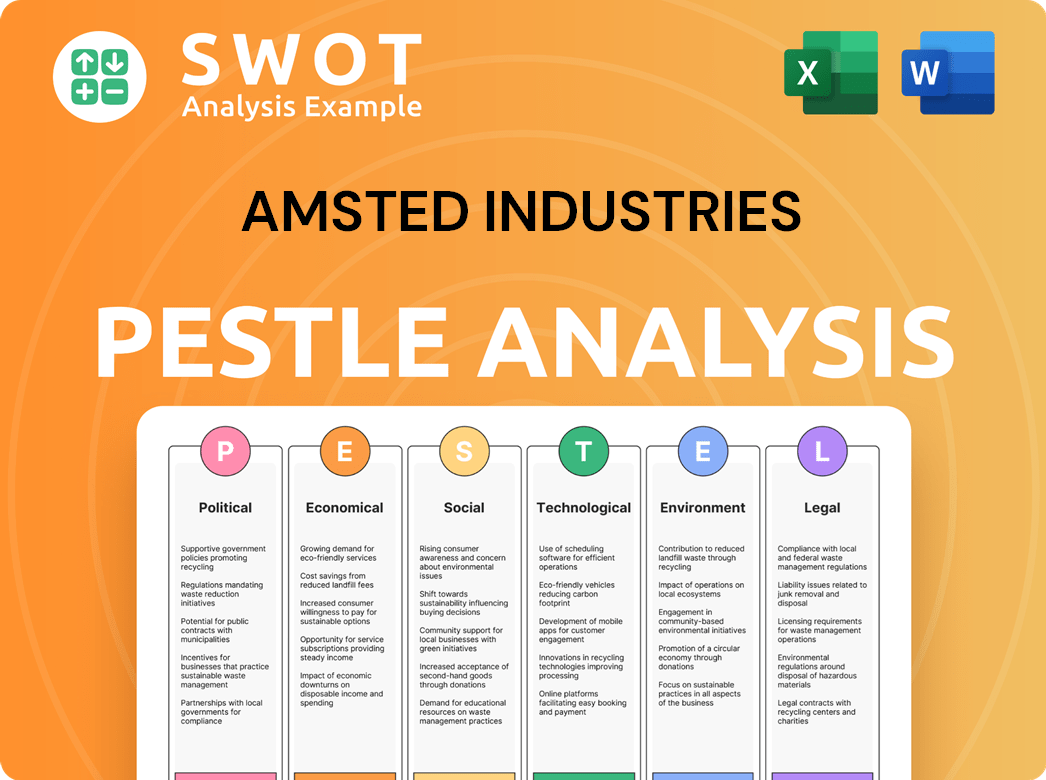
What are the key Milestones in Amsted Industries history?
The Amsted Industries has a rich history marked by significant milestones in the railroad industry and manufacturing sectors. From its early focus on engineering to its expansion through acquisitions and technological advancements, the company has consistently evolved to meet market demands and industry challenges, solidifying its position as a key player in its core markets.
| Year | Milestone |
|---|---|
| 1910 | Established a product engineering facility in Granite City, Illinois, expanding testing for car parts and springs. |
| 1992 | Acquired the Ceramic Cooling Tower Company, expanding its portfolio. |
| 2018 | Launched Amsted Digital Solutions, offering telematics solutions for freight rail. |
| 2021 | Amsted Automotive Group was formed by merging Means Industries and Burgess-Norton. |
Amsted Industries has consistently demonstrated a commitment to innovation, particularly within the railroad industry and automotive sectors. These innovations have resulted in significant advancements in product performance and efficiency.
Pioneered a patented process for Micro Alloy™ wheels, which provide up to a 72% longer service life in severe environments for the rail industry. This innovation significantly reduces maintenance costs and downtime for railroad operators.
Developed cutting-edge EV driveline technology, including its proprietary Dynamic Controllable Clutch (DCC) system for seamless engagement and disengagement of electric drivetrains. This system enhances the efficiency and performance of electric vehicles.
Introduced Bogie IQ™ technology in early 2022, which monitors wheel health and brake system performance without external sensors. This technology provides real-time data to improve rail safety and operational efficiency.
Despite its achievements, Amsted Industries has faced various challenges, including economic downturns and antitrust investigations. These challenges have tested the company's resilience and strategic adaptability.
A five-week strike at the American Steel Foundries division in 1990 impacted operations. This event caused temporary disruptions in production and supply chains.
Experienced declining sales across all three operating divisions in 1991, reflecting broader economic pressures. This downturn required strategic adjustments to maintain financial stability.
In 2005, the acquisition of FM Industries led to an antitrust investigation, requiring the divestiture of assets and licensing of intellectual property. This action aimed to restore competition in the market.
Experienced a mid-20% top-line decline in its fiscal third quarter of 2020 due to headwinds in heavy-duty truck and rail markets. This decline prompted the company to implement cost-saving measures.
Amsted Industries Business Model Canvas
- Complete 9-Block Business Model Canvas
- Effortlessly Communicate Your Business Strategy
- Investor-Ready BMC Format
- 100% Editable and Customizable
- Clear and Structured Layout
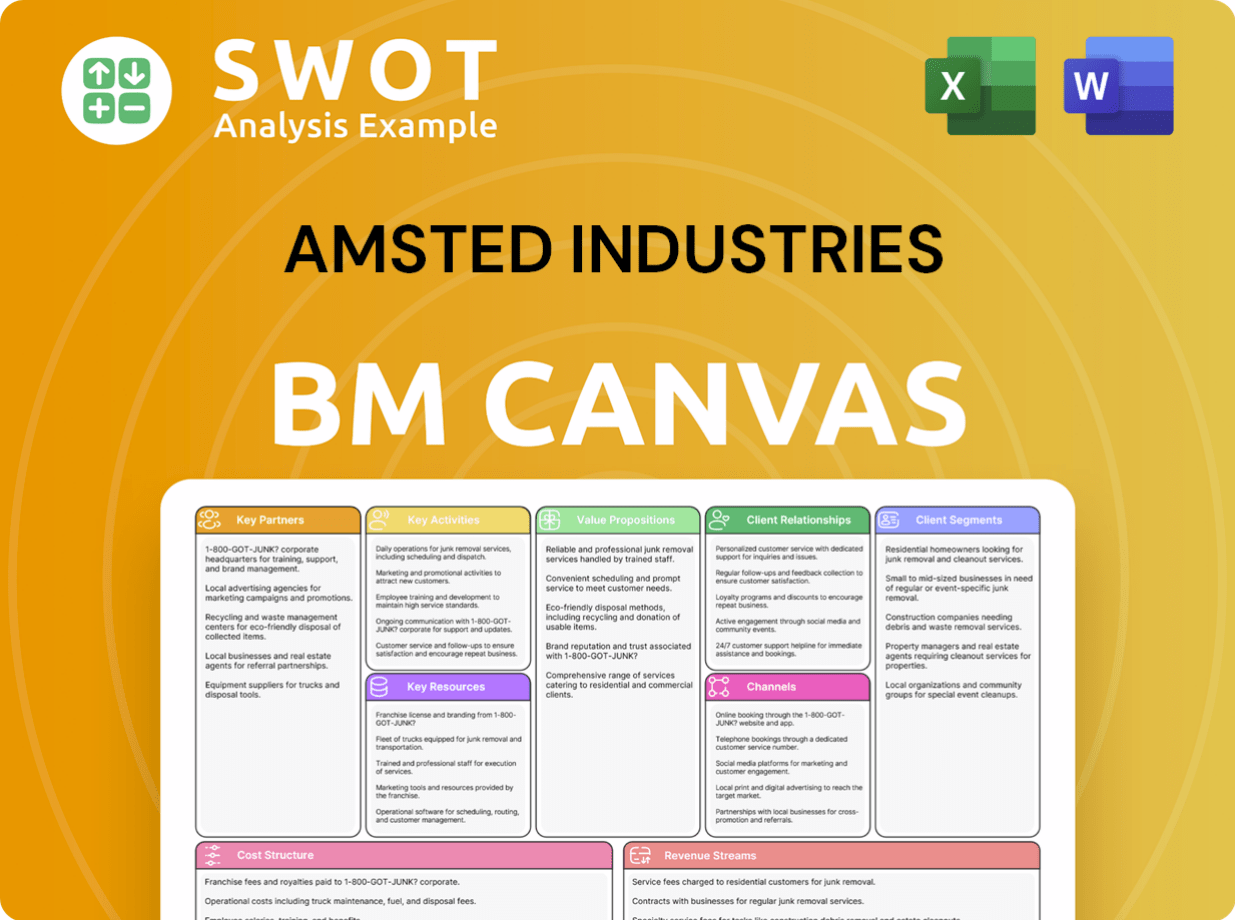
What is the Timeline of Key Events for Amsted Industries?
The Amsted Industries story is a journey through pivotal moments and strategic decisions. The company's evolution reflects its adaptability and commitment to innovation within the railroad industry and beyond. From its early beginnings to its current status as a 100% employee-owned entity, Amsted history showcases a dedication to growth and a strong market presence. The following timeline highlights key milestones in the Amsted company's development.
| Year | Key Event |
|---|---|
| 1877 | Griffin Wheel Company is founded, marking an early entry into the railroad industry. |
| 1902 | American Steel Foundries (ASF) is established through the merger of eight steel foundries. |
| 1903 | Burgess-Norton MFG is founded, expanding the company's manufacturing capabilities. |
| 1917 | ASF acquires Griffin Wheel, consolidating its position in the market. |
| 1922 | Means Industries is founded, contributing to the company's diversified portfolio. |
| 1938 | Baltimore Aircoil Company is founded, entering the thermal management sector. |
| 1949 | Brenco is founded, further strengthening the company's offerings. |
| 1950 | Diamond Chain Company becomes part of Amsted Industries, broadening its scope. |
| 1962 | American Steel Foundries changes its name to Amsted Industries, reflecting its broader scope. |
| 1968 | Amsted Industries acquires Burgess-Norton MFG, integrating its operations. |
| 1985 | Amsted Industries acquires Baltimore Aircoil Company, expanding its market reach. |
| 1986 | Amsted Industries goes private via an employee stock ownership buyout, establishing its ESOP. |
| 1998 | Amsted Industries becomes 100% employee-owned, fostering a unique ownership culture. |
| 2000 | ASF merges with Keystone to establish ASF-Keystone; AmstedMaxion joint venture is formed. |
| 2001 | Amsted Rail launches its Digital Transformation Journey, embracing technological advancements. |
| 2018 | Amsted Digital Solutions is formed, focusing on digital innovations. |
| 2020 | Amsted Graphite Materials is formed, diversifying its material offerings. |
| 2021 | Amsted Automotive Group is formed, combining Means Industries and Burgess-Norton. |
| 2023 | Amsted Rail opens a state-of-the-art Automation Center in Kansas City, enhancing operational efficiency. |
| 2024 | Amsted Industries hosts various internal and community events, including leadership training and a mentoring program. |
| 2024-2025 | Amsted Industries completes significant refinancing transactions, including a $500 million issuance of senior notes due 2033 and refinancing of its $1.4 billion credit facility and $225 million AR securitization facility. |
| 2025 | Amsted Digital Solutions divests GeoMetrix Rail TMS assets to focus on rail telematics. |
Amsted Automotive Group is actively developing solutions for electrified propulsion, indicating a strong commitment to the electric vehicle market. This strategic move showcases the company's adaptability to evolving industry trends. This forward-thinking approach positions Amsted Industries for growth in the automotive sector.
Amsted Digital Solutions continues to advance telematics and digital solutions to enhance safety and efficiency. The certified IQ Series onboard telematics technology is a prime example of innovation. These advancements underscore Amsted's commitment to leveraging technology in the railroad industry.
The company plans to leverage its legacy of innovation to lead and transform global businesses through technology panels and strong investment in R&D. With over 75 facilities in 13 countries and over 17,000 employees, Amsted Industries is well-positioned for global market expansion. This growth strategy aims to reinforce Amsted's market leadership.
The unique 100% employee-owned structure is expected to continue driving performance and a 'Spirit of Ownership' among its workforce. This ownership model fosters a culture of accountability and dedication. This structure is a key factor in Amsted's long-term success.
Amsted Industries Porter's Five Forces Analysis
- Covers All 5 Competitive Forces in Detail
- Structured for Consultants, Students, and Founders
- 100% Editable in Microsoft Word & Excel
- Instant Digital Download – Use Immediately
- Compatible with Mac & PC – Fully Unlocked
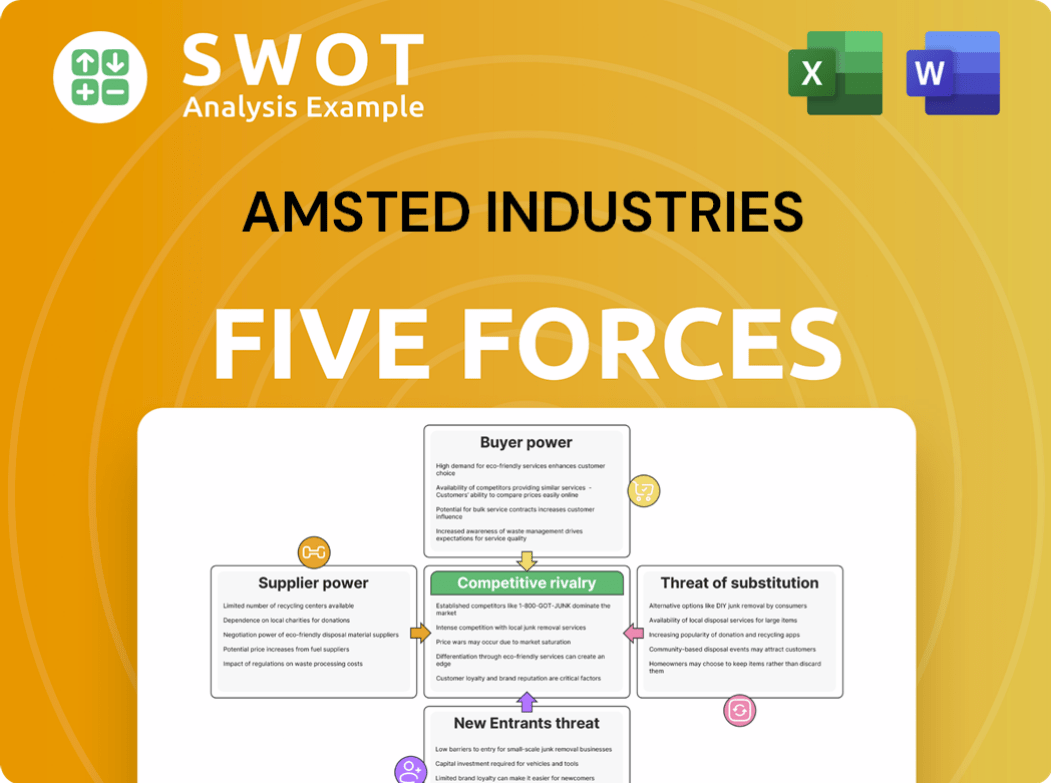
Related Blogs
- What is Competitive Landscape of Amsted Industries Company?
- What is Growth Strategy and Future Prospects of Amsted Industries Company?
- How Does Amsted Industries Company Work?
- What is Sales and Marketing Strategy of Amsted Industries Company?
- What is Brief History of Amsted Industries Company?
- Who Owns Amsted Industries Company?
- What is Customer Demographics and Target Market of Amsted Industries Company?
Disclaimer
All information, articles, and product details provided on this website are for general informational and educational purposes only. We do not claim any ownership over, nor do we intend to infringe upon, any trademarks, copyrights, logos, brand names, or other intellectual property mentioned or depicted on this site. Such intellectual property remains the property of its respective owners, and any references here are made solely for identification or informational purposes, without implying any affiliation, endorsement, or partnership.
We make no representations or warranties, express or implied, regarding the accuracy, completeness, or suitability of any content or products presented. Nothing on this website should be construed as legal, tax, investment, financial, medical, or other professional advice. In addition, no part of this site—including articles or product references—constitutes a solicitation, recommendation, endorsement, advertisement, or offer to buy or sell any securities, franchises, or other financial instruments, particularly in jurisdictions where such activity would be unlawful.
All content is of a general nature and may not address the specific circumstances of any individual or entity. It is not a substitute for professional advice or services. Any actions you take based on the information provided here are strictly at your own risk. You accept full responsibility for any decisions or outcomes arising from your use of this website and agree to release us from any liability in connection with your use of, or reliance upon, the content or products found herein.